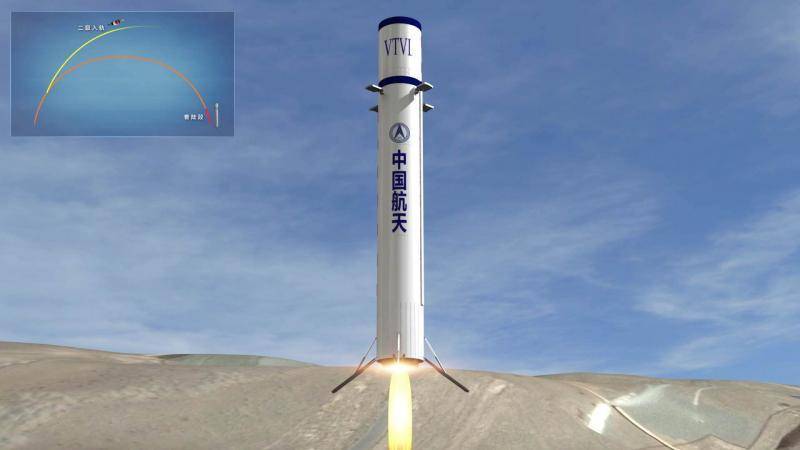


Last week, President Trump signed a Presidential Memorandum directing NASA to send astronauts back to the moon for long-term exploration and to prepare for the long-awaited manned Mars mission. The significance of the directive is unclear, however, as it comes without any clear budget or strategy.
Meanwhile, on the other side of the world, China has been making some ambitious space plans backed by multi-step procedures and lots of money. On the docket: reusable space plans, nuclear-powered spaceships, and robotic moon bases.

The China Aerospace Science and Technology Corporation (CASC) plans to fly its reusable space plane for the first time in 2020, and have it carry taikonauts and freight into space by 2025. The China Academy of Launch Technology (a CASC subsidiary) research and development Director Chen Hongbo told the official Xinhua News Agency that the two-stage spaceplane would be rocket-powered at first, and will be able to fly off a runway at hypersonic speeds to near space. It would then detach a reuseable second-stage rocket that would carry passengers and cargo and reach an altitude of 180-310 miles in orbit. In line with previous space plane plans, CASC will fly a scramjet-powered version of the first-stage carrier by 2030, thus increasing the second-stage payload.
The CASC program has competition, though. Vice Director Liu Shiquan of the rivaling China Aerospace Science and Industry Corporation (CASIC) said its own spaceplane program is off to a good start, with engines and other core technologies in advanced testing.

CASC also has equally ambitious plans for deep-space exploration. Key among these plans is for a nuclear-powered spacecraft, which is slated to enter service in 2040, most likely to support a manned Chinese Martian mission. CASC also has plans for China to engage in deep-space economic activity, like building orbit solar power plants, and mining asteroids and the moon.
To launch the thousands of tons of payload required to execute these plans, CASC is planning to make its rockets all completely reusable by 2035, from the small Long March 6 all the way to the giant Long March 5. The Long March 4B will test grid fins in 2019 (grid fins on reusable rockets like the SpaceX Falcon are used to control flight during the high velocity portion of the descent phase) and vertically land a Long March 6 rocket in 2020.

Similar plans in the U.S. depend on a new breed of private launch companies, owned by tech billionaires. These firms also have competition in China. The Chinese private space launch company Link Space is also betting on reusable rockets. Its New Line 1 rocket, a 33-ton spacecraft that can launch a 440-pound payload to sun synchronous orbit, will theoretically have a vertically landed first stage. What’s more, the company has already tested its rocket engines over 200 times, making good progress on plans for a first New Line 1 launch in 2020.

Also, the heavy Long March 9, which can carry 130 tons into low-earth orbit, or 50 tons into lunar orbit, will make its first flight by 2030. The Long March 9 will likely be used for manned missions to the moon as well as installing orbital solar power plants. Its massive payload capacity would also support Chinese plans to explore Jupiter, Saturn and its moons, and other celestial objects beyond the asteroid belt.

The Long March 9’s huge payload could come in handy for creating a base on the moon as well. It’ll likely be a robotic facility; a manned base would cost a whole lot more. Jiao Weixin of Peking University says that a robot base dug into the lunar surface, unlike lunar rovers and landers, could conduct more sophisticated scientific tests of lunar soil, and cheaply send back lunar rock samples.
Researching and operating all this is going to be very expensive, but it is clear China views the new space race as a way to pick up a lot of prestige. These new plans will be added China’s already wide range of space offerings, including navigation and spy satellites, a vibrant hypersonic technology industry, and growing robotics and AI industries.
You may also be interested in:
- China Plans to Launch Rockets Into Space From Massive Freighters and Planes
- American and Chinese Aircraft Could be Flying 4,000 miles per hour by 2030
- China’s Hybrid Spaceplane Could Reset the 21st Century Space Race
- China’s Private Space Industry Prepares to Compete with SpaceX and Blue Origin
- China Aims for Humanity’s Return to the Moon in the 2030s
- China Claims Success With this ‘Reactionless’ Engine for Space Travel
- China’s Martian Lander looks for 2020, and a Name
Peter Warren Singer is a strategist and senior fellow at the New America Foundation. He has been named by Defense News as one of the 100 most influential people in defense issues. He was also dubbed an official “Mad Scientist” for the U.S. Army’s Training and Doctrine Command. Jeffrey is a national security professional in the greater D.C. area.
